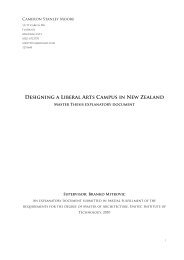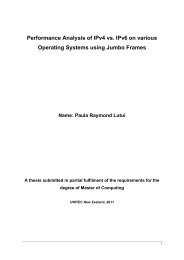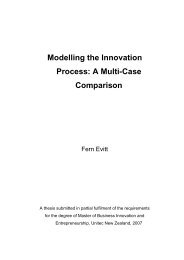The Study of Students Perceptions of On-campus ... - Research Bank
The Study of Students Perceptions of On-campus ... - Research Bank
The Study of Students Perceptions of On-campus ... - Research Bank
Create successful ePaper yourself
Turn your PDF publications into a flip-book with our unique Google optimized e-Paper software.
University – adopted 802.11n devices on <strong>campus</strong> late last year and one<br />
other – Duke University – planned to adopt the <strong>campus</strong>-wide 802.11n<br />
wireless network. Duke University’s chief information <strong>of</strong>ficer believed “the<br />
value <strong>of</strong> a technology like 802.11n is about enabling new kinds <strong>of</strong> uses on<br />
our <strong>campus</strong>, giving our students new opportunities, and enabling faculty to<br />
push the limits and try things that were not possible before on previous<br />
wireless technologies” (McLaughlin, 2008). Meanwhile, he also believed<br />
“Universities are an ideal testing ground for new technologies, especially<br />
wireless uses and devices, because students are spending their entire day on<br />
<strong>campus</strong> in a mobile manner. <strong>The</strong>y live, learn, work, and play on <strong>campus</strong>”<br />
(McLaughlin, 2008). According to McLaughlin (2008), the speed would be<br />
doubled if clients used 802.11g connect on to the 802.11n-based access<br />
points and the Duke University planed to deploy the new Cisco 802.11n<br />
access points to serve approximately 45,000 students, faculty, and staff.<br />
Certainly those two universities were doing their best to provide new<br />
technology and meet the demands <strong>of</strong> students and faculty, but the article<br />
did not state what the demands <strong>of</strong> students and faculty were. Did they<br />
want what the university gave them? Maybe those universities’ IT<br />
departments could ask this question before they adopted new technologies.<br />
Cox (2008) reported that Duke University planned to install the largest<br />
wireless network 802.11n standard on the <strong>campus</strong>. According to Cox (2008),<br />
Duke University planned to cover 6 million square feet <strong>of</strong> <strong>campus</strong> by<br />
installing at least 2,500 Cisco Aironet 1250 access points in the following<br />
six to nine months. <strong>The</strong> 802.11n network would serve about 45,000<br />
students and faculty with a range <strong>of</strong> 2Mbps to 25Mbps. <strong>The</strong> speed would<br />
depend on the numbers <strong>of</strong> users. It could be 25Mbps if there were about<br />
five or six users and 2Mbps for up to 30 users. Duke University believed<br />
the wireless technology has become the primary connectivity mode for<br />
22











